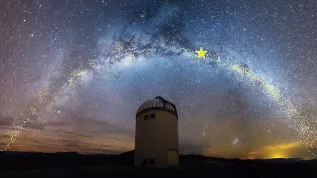
Polish design firm Bridge in collaboration with the European Southern Observatory (ESO) created an educational app presenting ALMA radio telescope network in 3D in the form of augmented reality. The application runs on smartphones and tablets.
The application allows the user to watch a 3D visualization of the network of 66 ALMA antennas. For the 3D effect, the user also needs a print-out of a special PDF file, so-called "tracker".
ALMA Augmented Reality application can be downloaded for free from Google Play and iTunes AppStore. The PDF file is available on the ESO website (www.eso.org/public/poland).
ALMA, the Atacama Large Millimeter/submillimeter Array, is a network of radio telescopes operating at millimeter and sub-millimeter wavelengths. The observatory was launched in March 2013. It is located in the Chajnantor plateau in Chile, at 5000 meters altitude.
The European Southern Observatory represents Europe in the ALMA project. In turn, the company Bridge is a Polish design and technical company, which develops technologies for augmented reality. The term "augmented reality" refers to systems that combine the real world with computer-generated real-time 3D graphics. (PAP)
cza/ krf/
tr. RL













